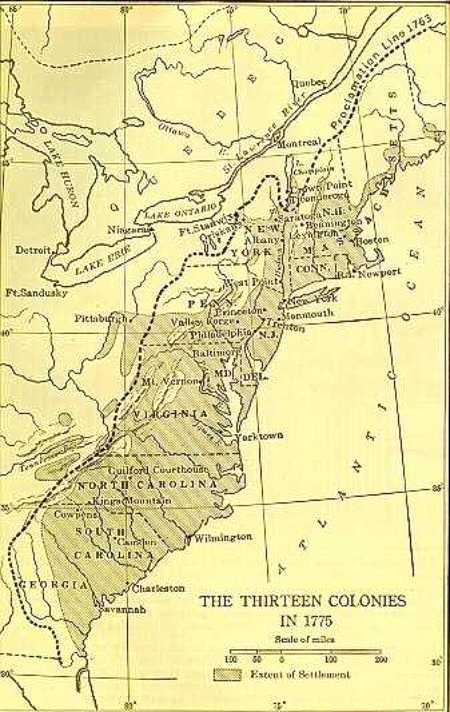
The Colonies
What is a "colony"? A "colony" is defined as "a body of people living in a new territory but retaining ties with the parent state." (Merriam-Webster dictionary) From 1607 to 1639, a total of six colonies were established in what is now the United States: Virginia, Massachusetts, New Netherlands (renamed New York), Maryland, Rhode Island and Connecticut. There were four basic types of colonies:
Joint-Stock Colony: investors fund a colony through a joint-stock company; examples were Virginia and Massachusetts Bay.
Charter Colony: founded on land granted by the king to a company or person who governed by it; examples were Connecticut and Rhode Island, which obtained charters many years after being settled.
Proprietary Colony: owned and controlled by 1 or more persons; examples were Maryland, Pennsylvania (William Penn), Delaware and New York.
Royal Colony: a colony founded or taken back under rule of king, who appoints the governor to rule it; many colonies eventually became royal colonies as the King took back control, as happened in Virginia.
The growing colonies in Massachusetts and Virginia could not have been more different from each other, and it is remarkable they eventually joined the same country. Massachusetts was highly religious and motivated by faith. Virginia was marginally religious and motivated by money. Massachusetts, more religious, had vocal opponents of slavery and neighboring Vermont was the first state to prohibit slavery in its Constitution, in 1777. In contrast, Virginia welcomed slavery. Massachusetts grew the Indian crop of corn. Virginia grew the Indian crop of tobacco. Massachusetts settlers made greater efforts to get along with Indians and treat them fairly. Massachusetts attracted new settlers based on religion. Virginia attracted new European settlers based on the "headright system," by which land (usually 50 acres) was given to those who paid for the passage to the colony of an immigrant, who usually agreed to work as an "indentured servant" for free for fixed number of years on the land.
The stark contrast between Massachusetts and Virginia would ultimately lead, nearly 250 years later, to the Civil War.
In between Massachusetts and Virginia there was a third approach: that taken by Pennsylvania. William Penn was another extraordinary Englishman. He converted to become a Quaker in England and began practicing that religion in violation of English law. Quakers believed in equality of all men in the sight of God: where then would be kings, lords and bishops? He was arrested and prosecuted, but the jury refused to convict him. The king owed his father money, and gave the son what is today Pennsylvania. It was nothing but woods at the time. But William Penn founded his colony based on one principle: religious freedom for all. He advertised in Europe and attracted peoples of many nationalities in addition to the English.
Penn was very kind to the Indians and soon had the most popular colony in America. Philadelphia, which means "brotherly love" in Greek, became America's greatest city, surpassing Boston in population in the 1700s. Only Pennsylvania and Maryland survived long-term under private ownership. Most of the other colonies were eventually taken over by the King of England, often due to troubles that arose in the colony.
Rhode Island Colony was founded by Roger Williams, a minister from Salem, who sought to protect Indian population whose lands were taken by force and given to English colonists. He also believed that all persons should be free in religious matters; no one should be compelled to attend church and to pay taxes to the church. He was banished from the colony and found refuge with Indians; with the founding of Providence the Rhode Island colony became independent from Massachusetts.
The Connecticut Colony was founded in 1639 with establishment of a town at Hartford; the colony was also built on more liberal principles than Massachusetts; New Haven colony was a restrictive Puritan society with elaborate punishments for misconduct in the community; existed till 1662, then was united to the Connecticut Colony.
Between the New England states and the Southern stated lies a group of states known as Middle States. They are New York, New Jersey, Pennsylvania, Delaware and Maryland. Delaware next to Rhode Island is the smallest state: began as early as 1638 with Swedish settlers, led by Peter Minuit. Soon enough became part of New York, in 1682 united to Pennsylvania; 20 years later became independent again. People who settled there were a curious mix of Swedes, Finns, the Dutch and the English.
Maryland originally began in 1634 with a settlement on Cheasepeake Bay in 1634. The founders were Lord Baltimore and his son, Roman Catholics. The settlers however practiced religious tolerance.
Georgia was founded in 1733 as a military front to protect the other colonies from the Spanish. The founder was James Oglthorpe, the English army officer and MP. He founded it with the hepl of a joint stock company to give a new chance to insolvent debtors; the chief town was Savannah.
So the original 13 colonies were: Massachusetts, Rhode Island, Connecticut and New Hampshire in the North; New York, New Jersey, Pennsylvania, Delaware and Maryland in the Middle groud; Virginia, North and South Carolina and Georgia in the South.

